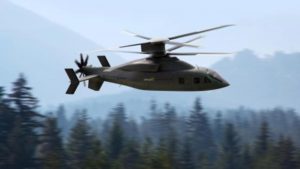
Image courtesy Sikorsky and Boeing
In Armada International, Andrew Drwiega examines the coming advances in attack aircraft, writing (abridged):
The US Army is on track to ensure that the two platforms that emerge from the Future Vertical Lift concept – FLRAA and FARA – will be the best prepared and most capable when they are delivered to their first unit equipped around 2030.
“We have had major aviation capability gaps for a while. We have tried to modernise at the same time as being engaged in major combat operations, but we are now focused on peer and near-peer competitors,” said Matthew Isaacson, chief of operations, Signature Modernisation Effort Integration Lead, US Army, speaking on 11 May at the Vertical Flight Society (VFS) forum on Future Vertical Lift (FVL).
The return to ‘peer’ type competition means has led to a number of significant changes away from the counter-insurgency (COIN) stance that has characterised the last couple of decades. With an opponent now capable of creating Anti Access/Area Denial (A2AD) areas, there is a requirement for new rotorcraft in particular to have greater reach and standoff performance in multi-domain operations.
While Isaacson confirmed that the Army’s legacy rotorcraft – the Boeing AH-64 Apache, Sikorsky UH-60 Black Hawk and Boeing CH-47 Chinook – will remain in front line service for some decades and potentially until the 2060s for the last aircraft in the fleet, FVL is the ultimate priority.
The US Army has devoted time and resources into getting its next generation aircraft right. It has engaged with industry and pushing forward from the concept of creating Joint Multi Role Technology Demonstrators (JMR TD), it has crystalised its view onto two specific platform types: the Future Long-Range Assault Aircraft (FLRAA) and the Future Attack Reconnaissance Aircraft (FARA).
The benefit of this extended development process, which in no small way required industry to reach deeply into its own pockets, has seemingly resulted in a steady focus on what is fundamentally required, without the diversions of mission creep that proved so costly to historical development programmes such as the Boeing-Sikorsky RAH-66 Comanche.
The major difference this time, said Isaacson, is that the Army’s prototyping regime has “shown that the core vehicle technology is enough for the Army to invest in, in ways we have not done before. Normally we wait until pre-Milestone C (the point at which production is initiated) to know if the core technology is there.” Milestone A is usually when technology maturation and risk reduction is initiated, while Milestone B triggers engineering and manufacturing development.
FLRAA
During a conflict against a more capable enemy than lightly armed fighters typical of a COIN operation, speed and range of manoeuvre may well be a critical factor, perhaps even to take advantage of a breach in the enemy’s A2AD defences.
“A lot of the Army’s manoeuvre capability is enabled by aviation,” said Colonel David Phillips, project manager, Program Executive Office FLARA, recalling how during Operation Desert Storm in 1991 three brigades of the 101st Airborne Division were moved up to 350 miles to block the Iraqi Republican Guard in 96 hours, one of the longest and largest air assaults to be attempted. Philips said that if you could take that requirement into today’s planning using FLRAA, it could be done in half the time at twice the distance.
“Coordination and collaboration is very important, and you will hear a lot about a Modular Open Systems Approach (MOSA), including between the new aircraft and the existing platforms,” said Philips.
For those who do not know the background to this programme, the downselected flying prototypes for the FLRAA programme comprise the Sikorsky-Boeing DefiantX, a compound co-axial rotorcraft, and the V-280 Valor tiltrotor from Bell. Both contenders have a history of development and designs around their particular platform design.
FARA
The contenders for the Future Attack Reconnaissance Aircraft (FARA) programme are once again Lockheed Martin Sikorsky with Raider X and Bell with its Invictus 360, a design based on its civil Bell 525 helicopter. This is not a tiltrotor.
Colonel Greg Fortier, project manager, FARA, also speaking at the VFS event in May, said that FARA was on the same development track as FLRAA with a Milestone B in 2024 and a target of first unit equipped in 2030. However, the later starting time for the FARA programme (in 2019) “was that they could leverage work already done by the Cross Functional Team (CFT) and JMR TD before it.
“We are aware the Army has tried this three times before [the Boeing–Sikorsky RAH-66 Comanche, Bell’s Armed Reconnaissance Helicopter ARH-70 Arapaho, and Armed Aerial Scout – multiple contenders], and we are doing this so much differently than before,” said Fortier. “We need to experiment, prototype and demonstrate a next generation air vehicle as quickly as we can. We have two roles: get the demonstrators flying by FY23 … and we are just south of halfway complete which is quite remarkable when you think contract was only awarded in FY19.”
“Not having the luxury of a competitive demonstration and risk reduction phase, we are somewhat overlapping them,” said Fortier. For the last 21 months the FARA team has been understanding the designs and their technical maturity, as well as understanding what adjustments need to be made towards the next iteration. This will feed into a draught RfP then full RfP to industry asking for flight data and weapons systems designs.
The rapid pace of the programme means that prototypes need to fly in FY23 to get into an EMD [engineering & manufacturing development] phase as quickly as possible to deliver in 2030. “We have a two year window to conclude the risk reduction activities outside of a formal competitive demonstration, but using events such as Project Convergence 20 and 21 (an ongoing campaign of learning that brings together new and developing technologies from across the Army) and also the specifically aviation focused EDGE 21 event (Experimental Demonstration Gateway Exercise) which was held at the Dugway Proving Ground, Utah. “We have been intertwined with the CFT, S&T partners to really understand the analysis and update the facts and assumptions. “We finished run-ups in March/April to get the A-CCD (Abbreviated – Capabilities Development Document) through the AROC (Army Requirements Oversight Committee) – validates the designs of the two proposed contenders – and got positive feedback,” said Fortier.
E.J. Smith - Your Survival Guy
Latest posts by E.J. Smith - Your Survival Guy (see all)
- “Happy I Found Richard C. Young’s Intelligence Report” - April 16, 2024
- Residents Lose Faith in Blue Cities - April 16, 2024
- Want to Make and Keep Generational Wealth? - April 16, 2024
- Your Retirement Life: Watching The Masters and More - April 15, 2024
- Fight Food Inflation with Gold - April 15, 2024














